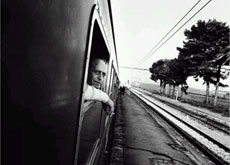
Switzerland prepares to review immigration policy

Parliament is preparing to overhaul legislation on immigration and the status of foreign residents.
During a week-long session beginning on Monday, it’s expected to draw up a new bill to replace the existing law, which dates back more than 70 years.
Although the 1931 law has been supplemented over the years with new provisions on immigration and the admission of refugees, it is becoming outdated.
Over the past 100 years Switzerland has seen its immigrant population rise, fall and rise again.
Following agreements with its larger neighbours on the free movement of people, the percentage of resident foreigners in Switzerland increased from 7.5 per cent of the population (211,000 individuals) in 1880 to 14.7 per cent in 1910 (552,000).
Fear of foreigners
The influx of foreign residents led to fears that Switzerland’s native culture would be diluted.
This concern increased over the following decades, even though the number of foreigners showed a steady decrease: from 10.4 per cent in 1920 (402,000) to 5.2 per cent (223, 000) in 1941.
In addition to concerns about employment, the debate continued to be dominated by worries about an influx of people who could not be assimilated, and foreign authoritarian ideologies spreading to Switzerland.
Under the terms of the 1931 law, the granting of temporary or permanent residence permits was based on “moral and economic” criteria.
The authorities had to take into account the state of the labour market and the “risk of being overrun by foreigners”, which was rather vaguely defined. Measures for keeping foreigners under surveillance were strengthened.
Economic expansion
After 1945, Switzerland resorted to immigrant labour on a grand scale to meet the needs of a rapidly expanding economy. Agreements were concluded with other countries regulating the admission and status of foreign workers.
Due to fears of an economic downturn, the initial emphasis was on admitting workers on a temporary basis and under certain conditions (for example, that they did not change jobs).
Different categories of guest worker were established: those living over the border and commuting to Switzerland every day; those granted seasonal or annual work permits; and those with a “C” permit, giving them the same status as Swiss citizens, but without the political rights.
To prevent the economy from “overheating”, but also to prevent a rise in social problems and xenophobia, efforts were made to stabilize the number of foreign workers. To encourage the integration of immigrant workers, arrangements were made for their families to join them.
The proportion of resident foreigners – which in 1960 had been just over ten per cent of the population – reached 17.2 per cent in 1970, or one million people, 54 per cent of whom were Italians.
Backlash
Nationalist or xenophobic movements have on several occasions triggered nationwide referendums on measures to limit the non-Swiss population.
During the recession of 1973-74, the immigrant population served as a social shock-absorber: seasonal or annual work permits were simply not renewed.
Over 200,000 immigrants left Switzerland at the time, and by 1980 the non-Swiss population had fallen to 14.8 per cent.
Since the 1980s, immigration has become inextricably linked with the issue of asylum. The country is witnessing an influx of people fleeing poverty or applying for political refugee status.
Once an occasional phenomenon caused by crises in different countries, the influx of refugees has become a permanent process, an aspect of globalization and the social and economic gulf between the rich and the poor worlds.
Three circles
While forging closer links with the European Union (with bilateral agreements ensuring freedom of movement), Switzerland has introduced legal measures making immigration from other countries more difficult.
This method of cultural and geographical discrimination, known initially as the “three circles policy”, was superseded in 1998 by an admissions system that makes a distinction between EU and European Free Trade Association members on the one hand, and the rest of the world on the other.
However, this has not prevented a structural change in the composition of the non-Swiss population: for some years now, nationals of the former Yugoslavia have outnumbered Italian immigrants.
Meanwhile, the percentage of foreigners has risen to 20 per cent, partly owing to the failure of moves to ease the naturalization of foreign residents.
swissinfo, Marco Marcacci
According to the most recent census, there are almost 1.5 million non-Swiss living in Switzerland, making up 20.1% of the population. 350,000 of the immigrant population are from former Yugoslavia. 316,000 are Italian.
Parliament is preparing to debate new legislation on immigration and the status of foreign residents to replace the present law dating from 1931.
The first waves of immigration occurred at the end of the 19th century, made possible by a series of agreements with neighbouring states on the free movement of people.
Today, Yugoslav nationals form the largest foreign community, followed by Italians, who for many years outnumbered all other immigrant groups.

In compliance with the JTI standards
More: SWI swissinfo.ch certified by the Journalism Trust Initiative

















![The four-metre-long painting "Sonntag der Bergbauern" [Sunday of the Mountain Farmers, 1923-24/26] had to be removed by a crane from the German Chancellery in Berlin for the exhibition in Bern.](https://www.swissinfo.ch/content/wp-content/uploads/sites/13/2025/12/01_Pressebild_KirchnerxKirchner.jpg?ver=a45b19f3)











You can find an overview of ongoing debates with our journalists here . Please join us!
If you want to start a conversation about a topic raised in this article or want to report factual errors, email us at english@swissinfo.ch.